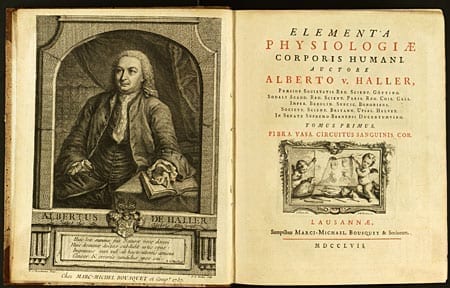Medicine was only one of the many interests of Albrecht von Haller. He was physician, anatomist, botanist, and physiologist, wrote poetry, studied religion and philosophy, and has been called the father of physiology and founder of hemodynamics.1,2
Born in 1708 in Bern, Switzerland, into a family of priests and magistrates, he was a weak and sickly but precocious child. By age four he had already read the Bible. He was at first educated privately, learning Greek, Latin, and even Aramaic. By age ten he was sent to the public school, and as a teenager he translated the classical Latin poets as well as composing poems, dramas, and historical epics.
Haller had at first intended to study theology, but later developed an interest in medicine. He began his medical education at Tübingen in Germany, then went on to Leiden to study and carry out research under the famous Hermann Boerhaave. On graduating in 1727 he visited London and Paris to further expand his knowledge of anatomy and medicine, then spent a year in Basel to attend classes in mathematics. In the summer of 1728, we find him wandering for one month in the Alps, writing poetry, looking at plants, and developing a passion for botany. Following this he returned to Bern to practice medicine, but, maintaining an interest in poetry, plants, and theology, was put in charge of the city library.
Lacking opportunities for advancement in Bern, perhaps on account of his stinging satires and poems, Haller moved in 1736 to Göttingen, Germany. There he was appointed professor of medicine, surgery, anatomy, and botany, and stayed until 1753. He built an anatomical theater, organized a botanical garden, started an obstetrics school, and carried out experiments that earned him the name of “the father of physiology.” In 1747 he published a classic textbook of physiology, Prima Linae Physiologicae. In his studies he used microscopy and injected arteries with dyes; studied the motion of the blood and the effects of bleeding; and investigated the process of vein thrombosis. He carried out studies on the function of the heart and circulation; the relation between atrial and ventricular contraction; and the effect of respiration on venous return and pulmonary blood flow. In his 1755 book Opuscula Pathologicae, Haller first described pericardial calcification. He studied the structure of the cardiac valves, published an anatomical atlas, and described the effects of stimulating muscles and nerves. He showed that the heart possessed intrinsic irritability and contractibility, continuing to beat when removed from the body despite not being connected to any nerves.
In 1764 Haller returned to Bern. There he held several held positions in education, politics, and health care. Despite his deteriorating health, he spent the last years of his life writing works of anatomy, surgery, and botany. He published three historical novels and several other literary and theological compositions, and had a plant genus, Halleria, named after him. Altogether, he is said to have published some twelve thousand articles on many different subjects. Suffering from a variety of medical illnesses, he became addicted to opiates in his final year and died on December 12, 1777, aged sixty-nine. He has been called the last of the great polymaths.
References
- Rémi C. Albrecht von Haller. Aufkärung 2010; 22:261 (in German).
- Fye WB. Albrecht von Haller. Clin Cardiol 1995; 18:291.
 |
GEORGE DUNEA, MD, Editor-in-Chief

Leave a Reply